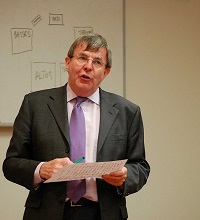
As thousands die, the UK must face up to its responsibilities on fuel poverty
Mari Martiskainen, University of Sussex
As we approach winter, many of us start turning the heating back on, but there are thousands of people across the UK who dread the onset of colder weather as they are forced into the fuel poverty trap. It is a phenomenon that kills, and worse, something we have become accustomed to. Another year, another set of headlines that should shock us into action, but rarely do.
In 2013, an estimated 2.35m households lived in fuel poverty in England. Furthermore, there are an estimated 26,000 deaths each year which can be linked to the cold weather during the winter months, and at least partly explained by fuel poverty.

Fuel poverty statistics for England (2003-2013)
DECC, 2015. Annual Fuel Poverty Statistics Report.
Fuel poverty is a persistent problem, but what exactly is it? There is no one global definition of fuel poverty, but many countries use the initial UK definition. In brief, you are in fuel poverty if you need to spend more than 10% of your income on heating and electricity in order to have the required energy services to cook, have lighting, keep warm, have a hot shower and so on. This definition has been updated since, but the old version is still widely used across EU countries. It also means that it is possible to be fuel poor even though you may not be otherwise living below the poverty line.
It is estimated that anywhere between 50m-125m people live in fuel poverty in the EU, and that figure is expected to rise in the coming years. Whichever end of that range you choose to believe, then this is a significant number considering that there are around 500m people living in the EU. While the issue of fuel poverty has been recognised in many countries, awareness is still lacking.
Cause and effect
There are usually three causes linked to fuel poverty: the poor energy efficiency of housing stock; high energy bills; and low incomes. As a combination, these three factors often mean that people vulnerable to fuel poverty have to make hard decisions over which room of the house to heat and whether to wash clothes by hand or not wash them at all. Furthermore, being fuel poor also means that you are more likely to suffer from poor health, especially respiratory diseases like asthma, as well as anxiety and depression. The Fuel Poverty Advisory Group estimated in February that the impact of cold homes cost the NHS some £1.36 billion every year.
There have been numerous programmes in the UK, which have been aimed at fuel poverty, including the Winter Fuel Payments. However, it seems that official action on fuel poverty has not been able to get to the root of the problem – especially given that the government’s commitment to deliver energy efficiency measures has reduced considerably in the last two years.
Being fuel poor often has a stigma attached to it and it is not always easy for authorities to immediately recognise those who may be in need of help. The persistence of the problem has prompted others to dive in. These have included health workers, who can see a benefit in helping those who live with fuel poverty and have respiratory or other health complaints. It is a simple equation as lifting people out of fuel poverty usually also improves their health, which then reduces their need for hospital visits. You also get interventions from civil society; community groups which address sustainable energy often have both the means and the motivation to offer help.

Energy Cafe in action.
South East London Community Energy (SELCE)
Those community-run initiatives can include “energy cafés” like the events run by South East London Community Energy. Around ten energy cafes have been set up across the UK by different groups, to provide information and advice for those vulnerable to fuel poverty. They often involve getting volunteers into a high street location for a limited amount of time, from where they can hand out advice about energy issues to the public. This might focus on energy market engagement – like how to switch energy providers, on energy efficiency or behaviour change. These community-led cafés are pretty well placed to reach those at risk of fuel poverty; it can be as simple as an informal discussion over a cup of tea.
Stepping in
However, the immediate question this raises is clear. When ad hoc initiatives start to address national concerns, then it is time to ask whose responsibility is it really to tackle fuel poverty, and who should pay for it? Should it be community groups, health authorities or the government?
Community groups are well placed to access people in a subtler manner than government agencies or energy companies might be able to. However, many rely on volunteer time and grant money – both often intermittent and limited.
While fuel poverty has been tackled from many angles, the problem ultimately cannot be solved without dedicated, long-term, government action to address the quality of the housing stock, not only in terms of improved energy efficiency but also in terms of improved quality of life. It is vital that we as a society address fuel poverty as part of a wider ethics issue, and ask the government can it really afford to lose another 26,000 people to fuel poverty this winter?
![]()
Mari Martiskainen, Research Fellow, University of Sussex
This article was originally published on The Conversation. Read the original article.
Follow Sussex Energy Group







 So what can we conclude from this report? It may reflect growing disillusion within the nuclear community with the large reactors currently proving so hard to finance and deploy. Whether this is the case or not, ETI – while advocating early development of SMRs in the UK – have in practice demonstrated quite how thin the current case for SMR pursuit really is.
So what can we conclude from this report? It may reflect growing disillusion within the nuclear community with the large reactors currently proving so hard to finance and deploy. Whether this is the case or not, ETI – while advocating early development of SMRs in the UK – have in practice demonstrated quite how thin the current case for SMR pursuit really is.


